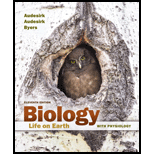
Concept explainers
Unstable Atoms Unleashed
Scientists believe that the isotopes Of uranium were forged in the explosion of a star and became incorporated Mo Earth as our solar system formed, today the radioactive form of this rare element is mined and concentrated to help satisfy humanity unquenchable desire for energy.
The chain reaction that generates heat in nuclear power plants begins when neutrons are released from radioactive uranium. These bombard other uranium Moms and cause them to split, in a self-sustaining chain reaction. When the tsunami struck the Fukushima plant, neutron-absorbing rods were immediately low-red around the fuel, halting the Cham reaction. But the breakdown of uranium generates additional radioactive isotopes, and these continued to spontaneously decay and generate heat This caused the disastrous breach that released these isotopes into the environment One isotope of particular concern is radioactive iodine.
Iodine enters the body in food and water. It becomes concern trated in the thyroid gland, which uses iodine to synthesize thyroid hormone. Unfortunately, the thyroid gland does not distinguish between radioactive and non-radioactive iodine-Children exposed to radioactive iodine are at increased risk for thyroid cancer, which may occur decades after exposure. To help protect them, Japanese authorities distributed iodine tablets to children near the tailed reactor this non-radioactive iodine satiates the thyroid, which then does not take up the radioactive form. Only time will reveal the full health effects of the fallout from Fukushima
CONSIDER THIS The Fukushima disaster led to a reassessment of safety precautions m nuclear power plants and a worldwide dialogue about the dangers of nuclear power, which also generates waste that remains radioactive for thousands of years. How can societies evaluate and compare the safety of nuclear power versus the safety of burning fossil fuels, from which humanity currently gets most of its energy? How can one compare the possibility of events that might cause a nuclear disaster—such as a magnitude 9 earthquake or the accidental escape of radioactive waste—with the certainty of continued carbon dioxide emissions and global climate change resulting from fossil fuel use? To what extent should societies invest m renewable energy, including wind and solar power?
Want to see the full answer?
Check out a sample textbook solution
Chapter 2 Solutions
Biology: Life on Earth with Physiology (11th Edition)
- Describe the principle of homeostasis.arrow_forwardExplain how the hormones of the glands listed below travel around the body to target organs and tissues : Pituitary gland Hypothalamus Thyroid Parathyroid Adrenal Pineal Pancreas(islets of langerhans) Gonads (testes and ovaries) Placentaarrow_forwardWhat are the functions of the hormones produced in the glands listed below: Pituitary gland Hypothalamus Thyroid Parathyroid Adrenal Pineal Pancreas(islets of langerhans) Gonads (testes and ovaries) Placentaarrow_forward
- Describe the hormones produced in the glands listed below: Pituitary gland Hypothalamus Thyroid Parathyroid Adrenal Pineal Pancreas(islets of langerhans) Gonads (testes and ovaries) Placentaarrow_forwardPlease help me calculate drug dosage from the following information: Patient weight: 35 pounds, so 15.9 kilograms (got this by dividing 35 pounds by 2.2 kilograms) Drug dose: 0.05mg/kg Drug concentration: 2mg/mLarrow_forwardA 25-year-old woman presents to the emergency department with a 2-day history of fever, chills, severe headache, and confusion. She recently returned from a trip to sub-Saharan Africa, where she did not take malaria prophylaxis. On examination, she is febrile (39.8°C/103.6°F) and hypotensive. Laboratory studies reveal hemoglobin of 8.0 g/dL, platelet count of 50,000/μL, and evidence of hemoglobinuria. A peripheral blood smear shows ring forms and banana-shaped gametocytes. Which of the following Plasmodium species is most likely responsible for her severe symptoms? A. Plasmodium vivax B. Plasmodium ovale C. Plasmodium malariae D. Plasmodium falciparumarrow_forward
- please fill in missing parts , thank youarrow_forwardplease draw in the answers, thank youarrow_forwarda. On this first grid, assume that the DNA and RNA templates are read left to right. DNA DNA mRNA codon tRNA anticodon polypeptide _strand strand C с A T G A U G C A TRP b. Now do this AGAIN assuming that the DNA and RNA templates are read right to left. DNA DNA strand strand C mRNA codon tRNA anticodon polypeptide 0 A T G A U G с A TRParrow_forward
 Biology Today and Tomorrow without Physiology (Mi...BiologyISBN:9781305117396Author:Cecie Starr, Christine Evers, Lisa StarrPublisher:Cengage Learning
Biology Today and Tomorrow without Physiology (Mi...BiologyISBN:9781305117396Author:Cecie Starr, Christine Evers, Lisa StarrPublisher:Cengage Learning
 Biology: The Unity and Diversity of Life (MindTap...BiologyISBN:9781337408332Author:Cecie Starr, Ralph Taggart, Christine Evers, Lisa StarrPublisher:Cengage Learning
Biology: The Unity and Diversity of Life (MindTap...BiologyISBN:9781337408332Author:Cecie Starr, Ralph Taggart, Christine Evers, Lisa StarrPublisher:Cengage Learning Biology: The Unity and Diversity of Life (MindTap...BiologyISBN:9781305073951Author:Cecie Starr, Ralph Taggart, Christine Evers, Lisa StarrPublisher:Cengage Learning
Biology: The Unity and Diversity of Life (MindTap...BiologyISBN:9781305073951Author:Cecie Starr, Ralph Taggart, Christine Evers, Lisa StarrPublisher:Cengage Learning Biology: The Dynamic Science (MindTap Course List)BiologyISBN:9781305389892Author:Peter J. Russell, Paul E. Hertz, Beverly McMillanPublisher:Cengage Learning
Biology: The Dynamic Science (MindTap Course List)BiologyISBN:9781305389892Author:Peter J. Russell, Paul E. Hertz, Beverly McMillanPublisher:Cengage Learning





